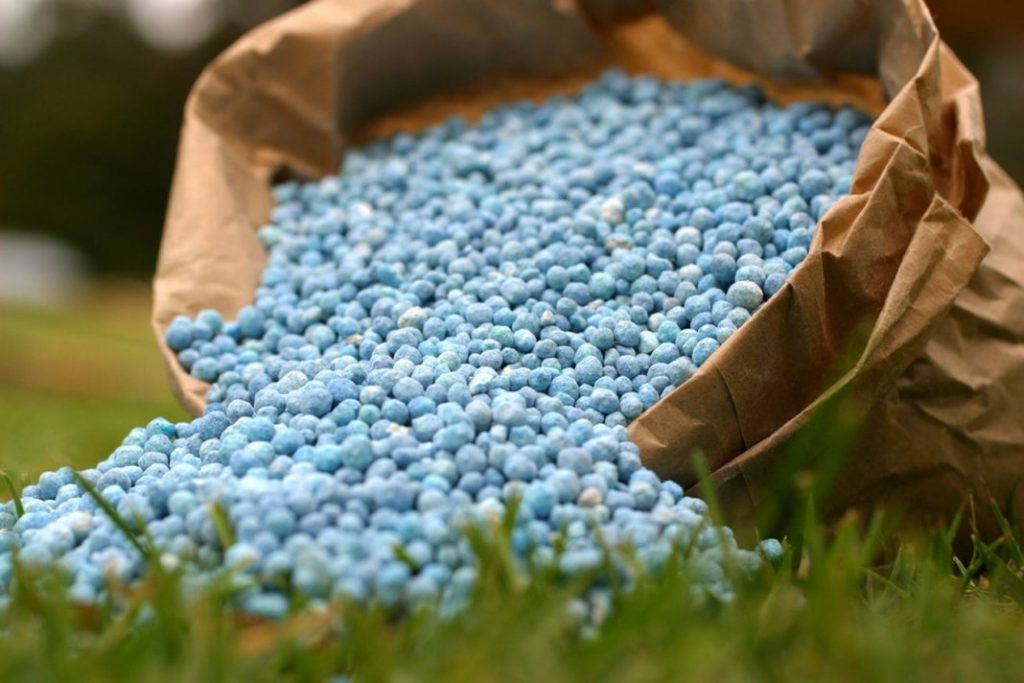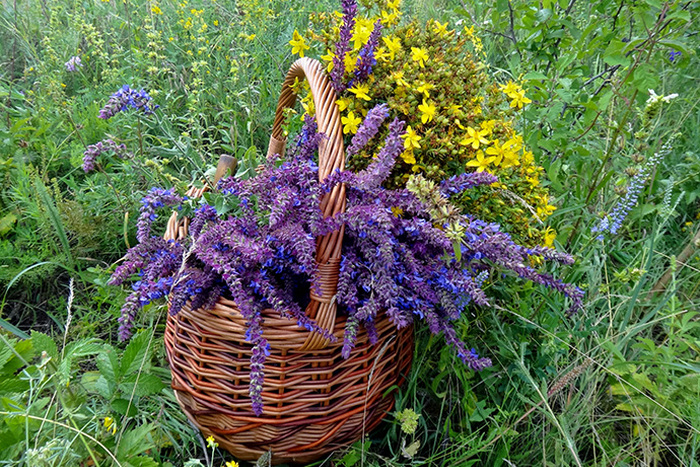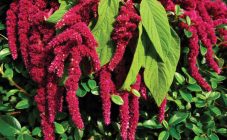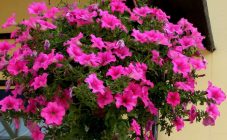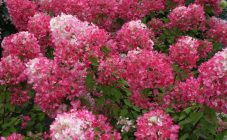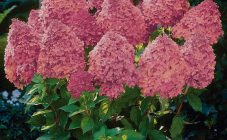Content:
Oak sage is a low herbaceous shrub. Flowers, fruits, leaves of the plant are used in cosmetology, folk medicine, cooking, and landscape design. With proper care, it blooms throughout the season, creating a beautiful corner of purple, blue or purple in the garden.
Shrub description
The second name for sage is salvia, which is translated from Latin as “to be healthy”. Therefore, it is used by pharmaceutical companies to produce medicinal products. The most common types of sage are:
- Sage officinalis is a bush up to 70 cm high. Leaves are gray-green, narrow, elongated. The stem is densely covered with whitish villi. It is used in medicine, cooking, cosmetology. There are several varieties, the most common: Breeze, Nectar, Aibolit, Semko Patriarch.
- Sage (oak) grows naturally on forest edges and on hillsides. It is a spicy herb with a herbaceous stem and lanceolate leaves. Inflorescences of a purple or blue hue are spike-shaped. In turn, it is subdivided into low-growing varieties: their inflorescences bloom with blue, purple, purple flowers (for example, Blue Queen forest salvia) and tall, spike-shaped inflorescences of which have a wider palette of colors: from white and pink to blue and purple (for example, Caradonna sage ).
- Clary sage is a type of forest sage. The leaves have an unusual color: yellow-green, for which it is also popular in ornamental gardening.
Oak sage belongs to the Yasnotkovye family. The height of this herbaceous shrub varies from 30 to 90 cm, its leaves are 3.5 to 10 cm in length and 1.5 to 3 cm in width. At the bottom, the stem lignifies over time, above it remains herbaceous. In winter, the top can freeze out, but in spring the plant quickly recovers.
Flowers are collected in whorls, which are located along the stem at a distance of 1.5 cm. It blooms all summer, fruits in the form of triangular-spherical nuts are formed in August-September.
Growing
In order for Salvia Dubravnaya to take root well and grow quickly, she needs to find a good place in the garden. Bushes grow quickly, so they should not be planted too close to each other. The distance to the next plant depends on its size, on average, planting is done according to the scheme: 50 × 50 or 60 × 60 cm.
A place for landing is chosen well lit and warmed up by the sun. It is recommended to cover sage for the winter, as it is a heat-loving plant. The culture is drought-resistant, waterlogging is dangerous for it. In regions with frosty winters, it is grown as an annual plant.
The soil
Oak sage does not make great demands on the soil. The most important condition is that groundwater should not be too close to the surface.For the cultivation of salvia, both potting soil for indoor plants and ordinary garden soil are suitable.
In the fall, the soil is prepared for spring planting: a plot is dug up, flavored with humus and phosphorus-potassium fertilizers. The acidity of the soil should be normal.
Reproduction
It is produced in several ways: by seeds, cuttings, dividing the bush, air layering. Which of the methods to use, the gardener decides for himself after studying the characteristics of each of them.
Through seedlings
Seeds can be sown directly into the ground in spring or autumn, or by pre-growing seedlings. The second method is used more often, since when sown directly into the ground, sage grows slowly. Sowing for seedlings usually begins at the end of winter.
Drainage is laid at the bottom of the tank, for example, expanded clay. Then light, loose soil pours out. Seeds are sown on top, sprinkled with earth a little and slightly moistened. To keep moisture in the soil for a long time, you can use a hydrogel. It is soaked in water, in which it soon swells, and is mixed with the soil.
After the appearance of the fourth leaf, the seedlings dive into separate pots. Before the beginning of summer, the seedlings have time to get stronger. After about 2.5 months, seedlings can be planted in open ground, having previously hardened them. To do this, in April they are taken out for several hours a day.
At first, it should be a shady place, then gradually you can accustom the seedlings to the direct rays of the sun. Also, several sage bushes can be left in pots for growing on windowsills, creating favorable conditions for them.
Seed in open ground
Sage is planted in this way in early spring or late autumn. Here's how it's done:
- the soil is dug up, leveled with a rake, sprinkled with calcined sand, on which the seeds are laid;
- sand is sprinkled on top, the bed is moistened and covered with a film;
- the planting is periodically ventilated, but at the same time you need to make sure that the garden bed always remains moist.
After about 3 weeks, the shoots will hatch. After 3-4 leaves appear, the film is removed.
Cuttings
To do this, the shoot is cut with a sharp knife just below the knot about 10 cm long and placed in a glass of water. After 2-3 weeks, roots are formed, visible through the glass. When they reach a length of 2 cm, the shoot is planted in a pot. The land should not be too nutritious.
At first, the plant is provided with increased moisture. To do this, the cutting is covered with a glass jar or plastic wrap, but the leaves should not touch the surface of the covering material. The greenhouse must be periodically ventilated so that the cuttings do not catch a fungal disease.
Planting pots should be deep because the root system of the salvia is well-branched. The stems of the bushes are flexible, the outermost ones spread along the ground, so they need a support. Or, in this case, you can apply another method of plant breeding.
Reproduction by layering
When the shoot comes into contact with moist soil, roots form at the nodes of the plant. Therefore, if the gardener wants to get sage shoots, he needs to ensure that the soil in the place of contact with the stem is always moist.Also, for reliability, the shoot can be pinned to the ground with something and lightly sprinkled.
Dividing the bush
This method is used in the southern regions. The division of the plant is done at the end of summer. Sage is gently undermined, the root is divided into parts. Delenka must have a root system and at least one stem. Each excavated process is planted in a separate planting hole.
Plant care
It consists in timely weeding, watering, fertilizing, plant pruning, protection from diseases and pests.
Watering and loosening
Irrigation must be timely. In this case, watering should not be plentiful. The procedure is performed in the morning or evening. When watering at noon, the sun's rays can burn the delicate leaves, and this will negatively affect the plant as a whole.
Loosening is also a necessary procedure. After it, moisture remains in the ground, oxygen is available to the roots. In addition, weeds are removed at the same time, taking away nutrients from the plant.
Fertilizer
Every spring you need to feed the bushes. First, nitrogen fertilizers are used to build up green mass. Then, 1 time in 3 weeks, liquid fertilizing is applied, for example, an aqueous solution of manure (1:10) or an infusion of weeds of the same concentration. Mineral fertilizers are used in the fall.
Pruning
This is an important procedure for a beautiful bush formation. If not produced, the sage will stretch out and age quickly. Pruning will trigger the awakening and growth of the lateral buds. As a result, the bush will intensively grow new shoots.
Diseases and pests
Sage is a spicy, medicinal plant that can independently fight various diseases. Therefore, it is little susceptible to various misfortunes. Improper care may be the reason for the poor condition of the bush.
- Mold can form with excessive moisture. Therefore, water stagnation in the soil should not be allowed. At the first appearance of mold, the plant is sprayed with a sulfur solution.
- Slugs and spider mites can appear in too dense plantings. Onion and garlic tincture is used as a control method. Laundry soap is added to the infusion so that the solution adheres well to the greens.
Harvesting
It is produced in summer and autumn. The first time at the end of June during blooming of inflorescences. It was at this time that sage had the greatest amount of essential oils required for use in cooking, cosmetology and for medicinal purposes.
The plant is mowed almost to the roots along with flowers and stems. At the end of September, an autumn collection of medicinal herbs is held. By this time, greenery appears again on the bushes, which grows violently after the previous pruning. Harvesting is done in dry weather.
Preparation for wintering
Frosty winters pose a threat to the plant. Therefore, when the first frost appears, the sage is trimmed so that it is convenient to cover it. Spruce branches, foliage, earth are used as a covering material. With a small number of cages, the bushes must also be covered with snow.
The benefits of sage
Salvia has anti-inflammatory and disinfectant properties, so the plant serves as a raw material for obtaining extracts, tinctures used in the preparation of medicines. They are prescribed for periodontal disease, inflammation of the tonsils.
Sage-based preparations are used to strengthen the nervous system, the leaves are added to tea to reduce sweating. Infusions and decoctions from it are used to strengthen hair follicles.
Varieties of varieties
Many varieties of oak sage have been bred by breeders. The most famous of them are:
- Sage Ostfritsland (Ostfritsland). Branched stems are about 40 cm long, leaves are slightly shriveled. Blooms all summer with purple and blue-violet flowers.
- Mainacht is a taller bush. Its inflorescences are purple, the leaves are oblong. Blooms several times per season.
- Schwellenburg differs from other varieties with purple and red inflorescences. It is widely used in gardens for decoration.
- Forest sage Ametist is a dense bush with dense candles of pink-purple inflorescences. After flowering, the bush remains neat, retains its shape.
- Forest sage Blauhugel is one of the unpretentious and cold-resistant shrubs. It has fragrant gray-green leaves, purple inflorescences. Blooms profusely in June and July.
- Oak sage Caradonna. The height of the bush is 70-80 cm, the inflorescences are lilac, the leaves are gray-green. It blooms from early summer until frost.
In addition to those listed, there are many more varieties of oak sage suitable for decorating a garden plot and characterized by a long flowering period.
Use in landscape design
Many gardeners plant oak sage to decorate the garden. Its spikelets of blue-violet color are beautifully combined with plants that have warm shades of buds: orange, yellow, red.
The description of the sage Caradonna deserves special attention. He has strong vertical stems, covered with gray-green leaves, and amazingly beautiful purple inflorescences. This variety always keeps vertical, never falls apart. It is combined with lavender, sedums, gray fescue, echinacea.
Sage is planted in the foreground or next to roses, lilies. In the alpine hills, it coexists with hyacinths, tulips, irises. By planting them with decorative cereals, the gardener will receive a landscape design in a rural style. Also, bushes are used to form a hedge.
Due to the wide area of application of oak sage, unpretentious care, this green space is one of the most common in garden plots, as well as terraces of houses and balconies of apartments.




